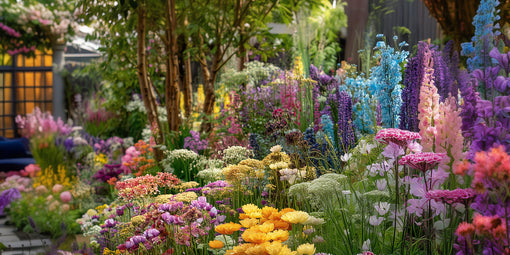
- Article published at:
Drawer menu

Lilies have been a part of human history for thousands of years and have been admired for their beauty and fragrance. Whether you're a seasoned gardener, a budding flower enthusiast, or simply looking for a unique way to brighten up your space, lilies are the perfect choice..
In this blog post, we'll dive into the world of lilies and discover why they are so special. From the different types of lilies to how to grow them, we've got you covered! Get ready to be mesmerised by the beauty of these stunning blooms, and learn how to incorporate them into your life in new and exciting ways. So grab a cuppa, put your feet up, and let's delve into the amazing world of lilies!

Lilies come in all shapes, sizes, and colours, and each type has its own unique charm! Let's take a closer look at some of the most popular types of lilies..
With so many types of lilies to choose from, it's easy to find one that fits your style and taste.

Lilies are a breath of fresh air among flowers, with unique and beautiful features that set them apart from the rest. With their tall, sturdy stems and big, gorgeous blooms that can reach up to 6 inches in diameter, lilies are a true classic flower.. And the best part? You get to enjoy their beauty for a long time because they bloom in different seasons, whether it's in the spring, summer, or fall.
With a rainbow of colours and patterns to choose from, from crisp whites to deep purples, lilies are the ultimate chameleons that can fit any style and mood. And let's not forget about their sweet fragrance that's sure to make your senses dance and attract some fluttering friends to your garden.
Whether you're a bold flower-lover or a fan of delicate beauty, lilies are the perfect pick for you. So go ahead, give them a place in your garden and experience their timeless charm and enchanting beauty for yourself!
Growing lilies is a wonderful hobby that can bring joy and beauty to your life! Whether you're planting them in your garden or in a pot on your balcony, these beautiful blooms are not only easy to grow but also low maintenance. Here's what you need to know to get started:

With a little care and attention, lilies can provide you with a stunning display of blooms year after year. Whether you're a seasoned gardener or just starting out, growing lilies is a fun and rewarding experience that is sure to bring a smile to your face. So, grab your gardening gloves, get outside, and start growing lilies today!
Lilies are not just beautiful, they are also versatile and have a variety of uses beyond just decorating your garden or home. Whether you're using them in bouquets, as cut flowers, or even in cooking and aromatherapy, lilies are sure to bring a touch of beauty and elegance to your life.

For example, their sweet fragrance makes them a popular choice for wedding bouquets and centerpieces, while their long vase life makes them perfect for brightening up your home for up to three weeks! And if you're feeling creative, you can even use petals in culinary dishes, as cute cake decorations, or as a natural scent in candles and soaps.
So, whether you're looking for a beautiful addition to your garden, a way to add a touch of elegance to your wedding, or just a new ingredient for your next culinary creation, lilies are a great choice. With their beauty, versatility, and charm, it's easy to see why these blooms have been loved by generations..
The only thing with lilies is that they might not always be pet friendly and its pollen gets everywhere. Luckily, we have figured out the best way to get rid of pollen stains, and even listed the best pet friendly flowers and plants so you can relax and enjoy your blooms!
Lilies are truly a gift from nature that bring beauty, elegance, and joy to our lives. With their oh-so-stunning blooms, captivating fragrance, and versatile uses, it's easy to see why these magnificent flowers have been prized for so many centuries.
So go ahead, plant a lily in your garden, bring a bouquet into your home, or simply enjoy their beauty from a distance.. With their timeless charm and enchanting beauty, lilies are sure to bring a smile to your face and bring a touch of magic into your life!
What's your thoughts on lilies? Let us know in the comment field below!